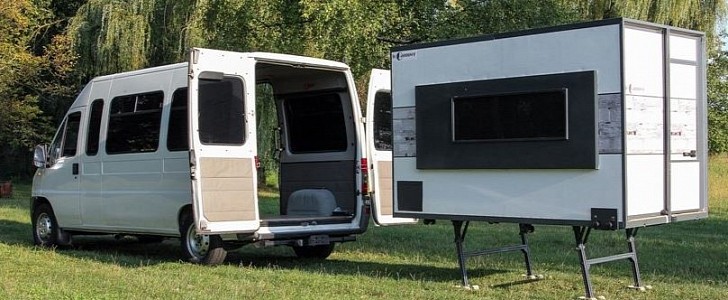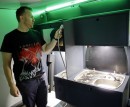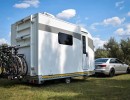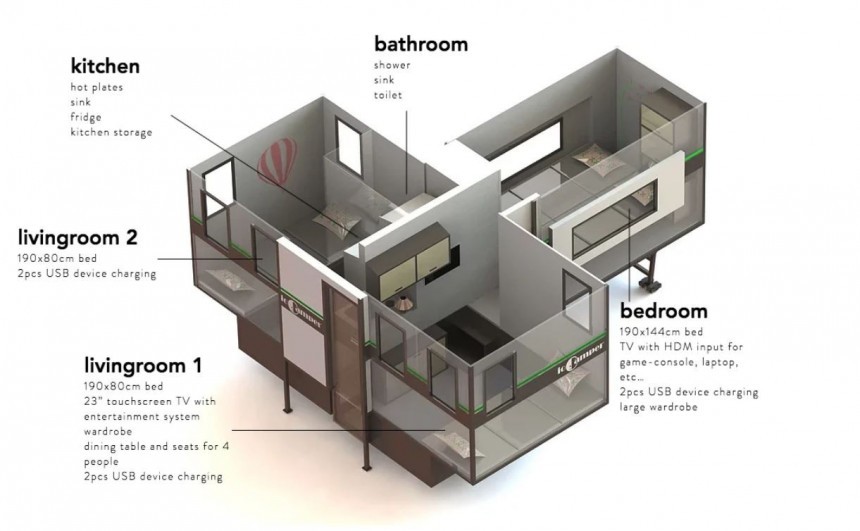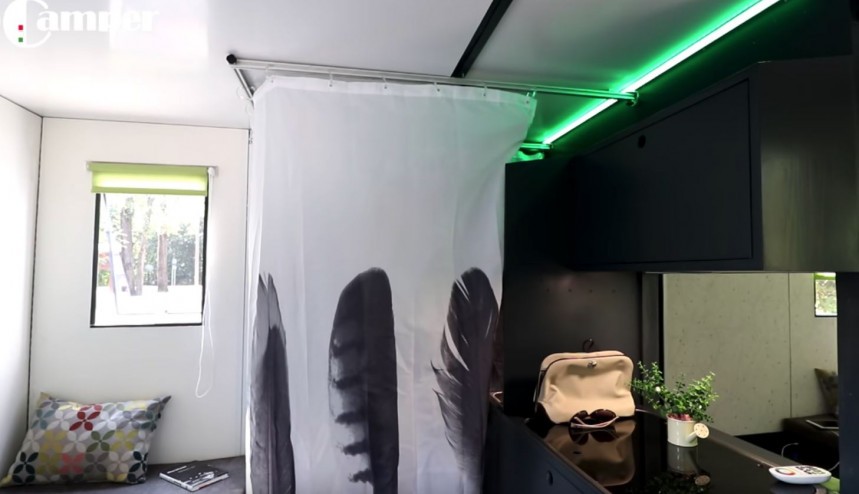A camping trip can often mean doing without certain creature comforts for the duration of the stay, but things tend to be a bit more complicated in this regard when you’re traveling with the kids. For most traveling families, space is a priority, as also are certain amenities to make the stay more home-like.
That said, not all families can afford or want to invest in a motorhome. Even a larger trailer poses additional challenges, including the need to have the right vehicle to tow it with. So, what if you could have a transportable home-like camper that could fit into a vehicle you already owned or could easily rent, like a van? Something like a box that you would slide into the back of the van and then slide out, and it would explode into a comfortable home once at camp?
That was the idea behind the ioCamper, arguably one of the most ingenious RV solutions of recent years. Created by engineer Tamas Laczko from Bekescsaba, Hungary, as a homemade project, it exists in prototype form only. It will remain a prototype for at least the foreseeable future since the original project has been scrapped and replaced with a new one. But more on that later.
Laczko started working on the ioCamper in 2016, and, two years later, with help from a team of local experts, including a bunch of electricians and constructors, he had the first prototype ready. It sounds like he was able to build two fully working models of the tiny box either before or right after he launched a crowdfunding campaign in 2018. The plan was to start mass production in 2019, but the campaign was a failure, which probably played a considerable part in ditching the project.
The other possible reason for the failure was the fact that, unlike with smaller items that seek funding for the first production series with such campaigns (think scooters, gadgets of all types, or even bigger stuff like e-bikes), no one would risk handing over large sums for a camper, no matter how revolutionizing it promises to be. Laczko could only offer thanks and t-shirts in exchange for pledges.
But the original idea was brilliant. The camper was a tiny box, with a floor area of no more than 3 square meters (32 square feet) and which you could fit inside the back of your van, without further modifications on the van except for the four screws you used to fix the box with. This meant that you lost none of the functionality of the van and would get a “camper” that was easy to remove and use or store.
At camp, the box would slide out of the van and then expand laterally and downwards, and floor space would quadruple to 12 square meters (129 square feet). The ioCamper offered three rooms and one common living area that also included the kitchen and a bathroom and sleeping for four people in full-size sleeping berths. The structure was made of heat-insulated sandwich panels and included fold-down furniture like beds and seating. You also got removable furniture that you’d have to stow away separately during transport.
The kitchen was not exactly fancy, but you got everything you needed for an extended weekend with the family, and that included throwing together a last-minute dinner request from your most fussy child. It had a dual-burner stove and a sink, and some cooking surface and, as long as you ignored the fact that it was located right next to the bathroom – and separated from it only by a privacy curtain – it would have had to do. On the bright side, the bathroom included a shower, as well as a sink and some storage.
The master bedroom came with a wall-mounted TV. A secondary screen served as command center, allowing you to control most stuff inside, from the lights and the AC to the fridge, and monitor battery and water levels. Solar panels on the roof and a battery pack, USB charging ports in every room, and the possibility to use a dedicated app for monitoring promised the ioCamper would be ready for the digital nomad. A digital nomad who drove a Peugeot Boxer, a Fiat Ducato, a Mercedes-Benz Sprinter, or an Iveco Daily, and was itching to hit the road with the family.
Pricing for the original model was never mentioned. A couple of local media outlets got the chance to see the prototype in action, reporting that it was well-crafted and sturdy, as well as easy to assemble (getting it from box to tiny house dimensions was a two-person job that took 10 to 30 minutes, tops) and comfortable. At camp, it was stable even on grass.
Regardless of what went wrong with the launch of the original model, there’s no sense in crying over spilled milk – or design ideas that never make it market. Laczko never gave up the idea and, earlier this year introduced the 2022 model of the ioCamper, which is a different yet considerably improved take on the original. It’s still a box but, this time, it sits on a flat trailer; it still expands into a T-shaped tiny home, but the finishes and the layout are improved. For one, the bathroom is a proper bath now, with walls of plywood. Available floor space is also bigger, at 17 square meters (183 square feet), which means the camper can sleep as many as six people.
Perhaps most importantly, the 2022 model is closer to reality than its predecessor. The pre-order books are open, with a fixed price of €22,990 ($26,000 at the current exchange rate) for the base model for all five configurations, which, strangely enough, are not detailed. Options include AC, RV-style cassette toilet, or the flat trailer for transport. The biggest downside is that there’s no mention of an estimated delivery date.
That was the idea behind the ioCamper, arguably one of the most ingenious RV solutions of recent years. Created by engineer Tamas Laczko from Bekescsaba, Hungary, as a homemade project, it exists in prototype form only. It will remain a prototype for at least the foreseeable future since the original project has been scrapped and replaced with a new one. But more on that later.
Laczko started working on the ioCamper in 2016, and, two years later, with help from a team of local experts, including a bunch of electricians and constructors, he had the first prototype ready. It sounds like he was able to build two fully working models of the tiny box either before or right after he launched a crowdfunding campaign in 2018. The plan was to start mass production in 2019, but the campaign was a failure, which probably played a considerable part in ditching the project.
But the original idea was brilliant. The camper was a tiny box, with a floor area of no more than 3 square meters (32 square feet) and which you could fit inside the back of your van, without further modifications on the van except for the four screws you used to fix the box with. This meant that you lost none of the functionality of the van and would get a “camper” that was easy to remove and use or store.
At camp, the box would slide out of the van and then expand laterally and downwards, and floor space would quadruple to 12 square meters (129 square feet). The ioCamper offered three rooms and one common living area that also included the kitchen and a bathroom and sleeping for four people in full-size sleeping berths. The structure was made of heat-insulated sandwich panels and included fold-down furniture like beds and seating. You also got removable furniture that you’d have to stow away separately during transport.
The kitchen was not exactly fancy, but you got everything you needed for an extended weekend with the family, and that included throwing together a last-minute dinner request from your most fussy child. It had a dual-burner stove and a sink, and some cooking surface and, as long as you ignored the fact that it was located right next to the bathroom – and separated from it only by a privacy curtain – it would have had to do. On the bright side, the bathroom included a shower, as well as a sink and some storage.
Pricing for the original model was never mentioned. A couple of local media outlets got the chance to see the prototype in action, reporting that it was well-crafted and sturdy, as well as easy to assemble (getting it from box to tiny house dimensions was a two-person job that took 10 to 30 minutes, tops) and comfortable. At camp, it was stable even on grass.
Regardless of what went wrong with the launch of the original model, there’s no sense in crying over spilled milk – or design ideas that never make it market. Laczko never gave up the idea and, earlier this year introduced the 2022 model of the ioCamper, which is a different yet considerably improved take on the original. It’s still a box but, this time, it sits on a flat trailer; it still expands into a T-shaped tiny home, but the finishes and the layout are improved. For one, the bathroom is a proper bath now, with walls of plywood. Available floor space is also bigger, at 17 square meters (183 square feet), which means the camper can sleep as many as six people.
